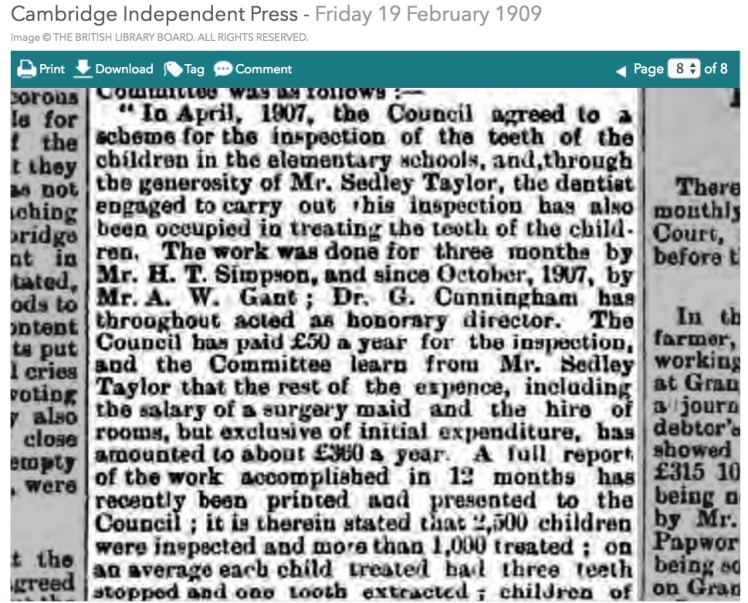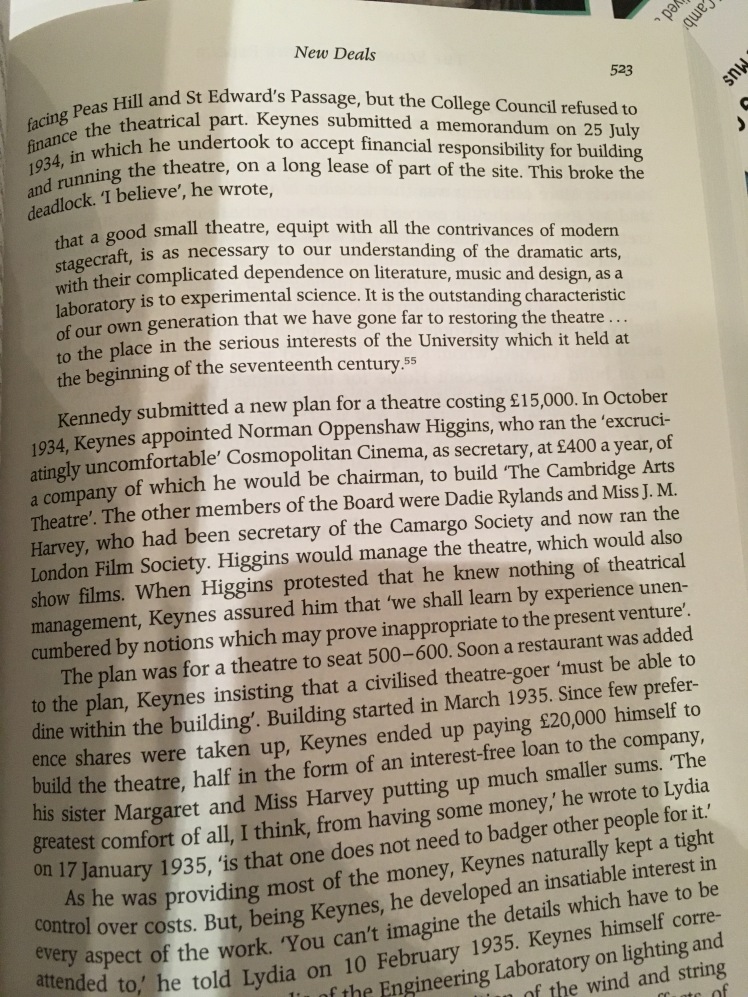Summary
Asking why so few books about Cambridge’s civic history exist dating from beyond the 1950s – and why trying to fill in the gaps is an incredibly huge task that no one person can complete alone.
I seem to have hit my first big lump of ‘historian’s block’ (if there is such a thing) with this whole Lost Cambridge project of mine. Probably a result of eating too many sweets and simple sugars of late at music rehearsals – such things make my mind go all scatty when it comes to thought processes.
…though I’d like to think I’m more a Robert Downey Jr Sherlock than Benedict Cumberbatch’s one.
Released around the same time as the TV series, I always found the cinema version more to my liking.
The conversation I had with historian Alice Wroe (who runs @Herstory)UK covering the women of history not covered in the curriculum and using art as the means of engagement) was one where I was sort of telling a story very, very quickly and randomly throwing in the names of various women she’d not heard of before, and mentioning how they were all connected to each other – but in a way where at the moment I seem to be one of the very few people who’s made those connections. A bit like Sherlock as explained here.
The problem is that content-wise there is ***so much to go through*** in order to get that big picture.
…Which means that it is perfectly understandable to see why since 1950, the history of Cambridge the town has become incredibly fragmented – to the extent that at the moment collectively we’ve lost many of the common links between people, places and objects.
For example:
- You can’t tell the story of commerce in Cambridge with the likes of Chivers of Histon, Eaden Lilley of Cambridge, and Robert Sayle of Cambridge without talking about how members of these families who set up and ran their businesses were also influential – and instrumental in the founding & running of a number of other institutions in Cambridge, (including schools, churches and local councils)
- You can’t tell the story of John Maynard Keynes and his years in Kings College without telling the story of the Arts Theatre that he founded and funded in the 1930s
- You can’t tell the story of Florence Ada Keynes as ‘Maynard’s Mum’ without telling the story of her at the Cambridge Charitable Organisation Society, a member of the Cambridge Ladies Discussion Society (later the National Council of Women’s Cambridge Branch), or her being Cambridge’s first woman councillor – in which she had to persuade Parliament to change the law to allow her to stand, and in the first set of three women magistrates in Cambridge, or being Cambridge’s second woman mayor, or how it was her who chaired the committee that ensured we got a big new guildhall after eighty years of debate
- You can’t tell the story of Eglantyne Jebb’s writing of Cambridge – a brief study in social questions in 1906, without telling the story of how she became a central figure in the Cambridge Liberal Party – almost running single-handedly their December 2010 campaign to get Stanley Buckmaster KC re-elected having lost his seat in the January 2010 election to Almeric Paget
- You can’t tell the story of Ellice Hopkins’ attempts at bringing her brand of Christianity to the slums of Cambridge without telling the story of how she gave some very blunt but true and honest feedback on how the churches, academics and politicians were failing the poor of Cambridge
- You can’t tell the story of Cambridge’s current public transport issues without telling the story of how Cambridge lost its old railway lines going to Oxford, Huntingdon, Mildenhall and Haverhill respectively
- You can’t tell the story of Cambridge’s current car traffic congestion without telling the stories of how planners decided to build car parks at Lion Yard, The Grafton Centre and Queen Anne Terrace.
- You can’t tell the story of the Grafton Centre without telling the story of the loss of the Kite communities
- You can’t tell the story of Arbury without telling the stories of the people who used to live in The Kite but who were moved out to the new post-war homes on the edge of town
- You can’t tell the story of the decline of ‘the port of Cambridge’ without telling the story of the rise of the railways
- You can’t tell the story of how Modern Cambridge became what it is without telling the story of Newnham College’s early students and graduates (and vice-versa)
And finally…
- You can’t tell the story of the University of Cambridge without telling the story of the borough and the town of Cambridge
And my point is that too many books about the history of the University of Cambridge and its colleges miss out on the role their members played in the history of the City of Cambridge.
***And the thing is that there are some really wonderful stories out there of some of the great things that some of the fellows of the colleges did for the people of Cambridge***
Two of my favourite are:
Sedley Taylor – Fellow of Trinity College who gave a donation of £500 in the early 1900s to found Cambridge borough’s first dentist and to pay the costs of a dental inspection for every child attending a council-funded primary school in the borough. Today that donation equates to around £50,000. And what an impact he had.

A clip from the Cambridge Independent Press from the British Newspaper Archive (£)
The article quotes:
“A full report of the work accomplished in 12 months has recently been printed and presented to the Council ; it is therein stated that 2,500 children were inspected and more than 1,000 treated ; on average each child treated had three teeth stopped and one tooth extracted.”
In Cambridge, we name minor side streets after our civic greats. Sedley Taylor Road being one such side-road/rat run between Long Road and Hills Road. Actually, in 2011 Sedley Taylor Road had the title of ‘Most expensive residential street in East Anglia‘. It’s a lovely road to walk and cycle down. I used to cycle down it daily in my teens on the way back from my paper round.
The other one is John Maynard Keynes’ gift to the people of Cambridge when he built the Cambridge Arts Theatre, funding its early years as well.

From Lord Skidelsky’s epic on Maynard Keynes.
As you can see from Skidelsky’s epic “Economist, Philosopher, Statesman” on Keynes, King’s College refused to finance the theatre bit of Keynes’ scheme for new accommodation for King’s students. (Keynes was a fellow at King’s). So he wrote a memorandum of understanding saying he’d foot the bill for the theatre. £20,000 in today’s prices is about…. £1.3million. The first time I went to a theatre was when Paddington The Musical came to Cambridge in the early 1980s – my grandparents took me and my brothers. My most recent visits were to see Yes Prime Minister and Avenue Q. And all because the founding father of Macroeconomics not only understood that there was far more to life than money, but that with the money he made he reinvested it in his home town for the good of the people. In the meantime across the road from the theatre, his mum, Florence Ada Keynes was overseeing the construction of the new Guildhall. I can’t help but think that at some stage, Maynard said to her: “Race ya!”
“You’ve still not answered the question titling this blogpost”
I got distracted.
There are two reasons/hypotheses I have as to why there are no epic tomes of Cambridge’s civic history. Well…three actually.
- Too much effort for too small an audience
- A sense that there are lots of books about Cambridge already – why write another one?
- That for my generation (aged 30-40) when we were at school in the 1980s/1990s, our parents and teachers were interacting with the people who would have been around in Cambridge at the time the last books on Cambridge’s civic history were published. Hence it’s not history, it’s contemporary.
One other thing that strikes me about local history is about how it has been marketed across the decades. Compare how military history shelves take up far more space than any other histories.
Now, I’m not saying that local history should be written as military history. Yet the struggles were just as epic, often involved love, violence and death – just not as systematic or on immediacy and scale say of the trenches in World War I. I’m still fascinated by the story of Cambridge Hero Frida Knight who drove an ambulance full of supplies to Spain to fight the fascists, smashed her way out of a nazi prison in occupied France and defied her pursuers to return to the UK via Spain, Portugal and Ireland, ultimately to return to Cambridge in 1970 where, 10 years later she wrote a wonderful book about the musical history of our city – culminating in rock’n’roll and the Cambridge Folk Festival. I just love the idea that in the middle of all these folk music fans in my neighbourhood when I was a baby, there was someone who had defied two of the most notorious dictators of the Twentieth Century to return to the sound of Don MacLean playing a wonderful acoustic version of American Pie.
Oh – there’s another reason why I really like her. Remember that big concert hall I want built and named after Florence Ada Keynes? In 1980. Frida Knight was thinking along the same lines.

Frida Knight in Cambridge Music
“A really spacious hall, with stage, orchestra pit, and seating for at least a thousand people (so as to make symphony concerts commercially viable) should surely be a priority for a great university with so remarkable a musical tradition, and for the rapidly growing City.”
That was in the 1970s. Nearly half a century has passed – and no, the Corn Exchange doesn’t count in my book because it’s not a specialist venue and doesn’t have the greatest acoustics in the world. Clue’s in the name ‘Corn Exchange’ as to why it was built.
But yeah – it’s going to take someone with a brain far more organised and disciplined than mine to work with me on this project. In fact, as I’ve mentioned before it’s going to need a team of us from a wide range of experiences and background and with a vast array of different talents. Who’s interested?
Hello,
Great stuff, but two small typos in Eglantyne Jebb point – both dates should be 1910. I hope you don’t mind my mentioning it. Thanks for keeping up the good work!
Cheers, Clare
http://www.claremulley.com
>
LikeLike